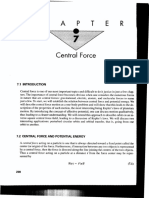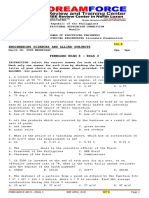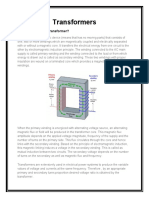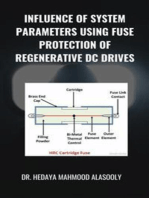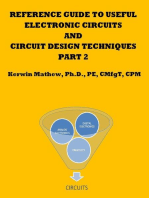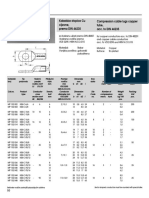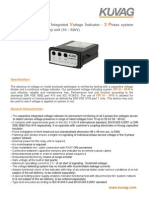Back To Transformer University
Uploaded by
registracijusBack To Transformer University
Uploaded by
registracijus12/20/13
Transformer Basics
Table of Contents
Chapter 1
Why We Use Transformers
Chapter 2
How Transformers Operate
Chapter 3
Three Phase Transformers
Chapter 4
Typical Transformer Construction
Chapter 5
Transformer Design Consideration
Chapter 6
Transformer Applications
Chapter 7
Special Applications
Back to Transformer University
www.federalpacific.com/university/transbasics/transbasics.html
1/1
12/20/13
Transformer Basics Chapter 1
Due to the high cost of transmitting electricity at low voltage
and high current levels, transformers fulfill a most important
role in electrical distribution systems. Utilities distribute
electricity over large areas using high voltages, commonly
called transmission voltages. Transmission voltages are
normally in the 35,000 volt to 50,000 volt range. We know
that volts times amps equals watts, and that wires are sized
based upon their ability to carry amps. High voltage allows
the utility to use small sizes of wire to transmit high levels of
power, or watts. You can recognize transmission lines
because they are supported by very large steel towers that
you see around utility power plants and substations. As this
electricity gets closer to its point of use it is converted,
through the use of transformers, to a lower voltage normally
called distribution voltage. Distribution voltages range from
2,400 to 25,000 volts depending upon the utility. Distribution
lines are the ones that feed the pole mount and pad mount
transformers located closest to your home or place of
business. These transformers convert the distribution
voltages to what we call utilization voltages. They are
normally below 600 volts and are either single-phase or
three-phase and are utilized for operating equipment,
including light bulbs and vacuum cleaners in our homes, to
motors and elevators where we work. This is the point at
which the Dry-Type Distribution Transformer comes into play.
It is used to convert the voltage provided by the utility to the
voltage we need to operate various equipment.
University
Entrance
Top
www.federalpacific.com/university/transbasics/chapter1.html
Table of
Contents
1/2
12/20/13
Transformer Basics Chapter 1
Next
Chapter
www.federalpacific.com/university/transbasics/chapter1.html
2/2
12/20/13
Transformer Basics Chapter 2
Voltage Transformers
A Transformer does not generate electrical power, it transfers
electrical power. A transformer is a voltage changer. Most
transformers are designed to either step voltage up or to step
it down, although some are used only to isolate one voltage
from another. The transformer works on the principle that
energy can be efficiently transferred by magnetic induction
from one winding to another winding by a varying magnetic
field produced by alternating current . An electrical voltage is
induced when there is a relative motion between a wire and a
magnetic field. Alternating current (AC) provides the motion
required by changing direction which creates a collapsing
and expanding magnetic field.
NOTE: Direct current (DC) is not transformed, as DC does
not vary its magnetic fields
A transformer usually consists of two insulated windings on a
common iron (steel) core:
The two windings are linked together with a magnetic circuit
which must be common to both windings. The link
connecting the two windings in the magnetic circuit is the
iron core on which both windings are wound. Iron is an
extremely good conductor for magnetic fields. The core is not
a solid bar of steel, but is constructed of many layers of thin
steel called laminations. One of the windings is designated
as the primary and the other winding as the secondary.
Since the primary and secondary are wound the on the same
iron core, when the primary winding is energized by an AC
source, an alternating magnetic field called flux is
established in the transformer core. The flux created by the
applied voltage on the primary winding induces a voltage on
the secondary winding. The primary winding receives the
energy and is called the input. The secondary winding is
discharges the energy and is called the output.
The primary and secondary windings consist of aluminum or copper
conductors wound in coils around an iron core and the number of ?
turns? in each coil will determine the voltage transformation of the
transformer. Each turn of wire in the primary winding has an equal
share of the primary voltage . The same is induced in each turn of the
secondary. Therefore, any difference in the number of turns in the
secondary as compared to the primary will produce a voltage change.
www.federalpacific.com/university/transbasics/chapter2.html
1/5
12/20/13
Transformer Basics Chapter 2
Windings
Step Down Transformers
If there are fewer turns in
the secondary winding
than in
the primary winding, the
secondary voltage will be
lower than the primary.
Step Up Transformers
If there are fewer turns in
the primary winding than
in the secondary
winding, the secondary
voltage will be higher
than the secondary
circuit.
Note: The primary winding is the winding which receives the
energy; it is not always the high-voltage winding.
When the primary winding
and the secondary winding
have
the same amount of turns
there is no change voltage,
the ratio is 1/1 unity.
Common single-Phase Voltage Combinations:
120 x 240 to 120/240; 480 to 120/240; 4160 to 240/480
208 to 120/240; 480 to 120/240; 4160 to 240/480
277 to 120/240; 2400 to 120/240
240 x 480 to 120/240; 2400 to 240/480
This relationship between the number of turns in the secondary
and primary is often called the turns ratio (also referred to as the
voltage ratio). It is customary to specify the turns ratio by writing
the primary (input) number first.
Example: 30 to 1 is a step-down transformer, whereas a 1 to 30
would be a step-up transformer.
Examples of Turn Ratio
Primary Secondary Turns Primary Secondary Terns
Windings Voltage Ratio Voltage Voltage Ratio
480
480
2/1
600
120
5/1
480
120
4/1
600
208
2.88/1
480
24
20/1
208
120
1.73/1
www.federalpacific.com/university/transbasics/chapter2.html
2/5
12/20/13
Transformer Basics Chapter 2
Winding Physical Location: In most transformers the high voltage
winding is wound directly over the low voltage winding to create
efficient coupling of the two windings.
Note: Other Designs may have the high voltage winding wound
inside, side-by-side or sandwiched between layers of the low
voltage winding to meet special requirements.
As stated previously, the voltage transformation is a function of the
turns ratio. It may be desirable to change the ratio in order to get
rated output voltage when the incoming voltage is slightly different
than the normal voltage. As an example, suppose we have a
transformer with a 4 to 1 turns ratio. With 480 volts input, the
output would be 120 volts. Suppose the line voltage is less than
the normal or 456 volts. This would produce an output voltage of
114 volts which is not desirable. By placing a tap in the primary
winding, we could change the turns ratio so that with 456 volts
input we could still get 120 volts output. This is called primary
output voltage tap and standard transformers may have from two to
six taps for the purpose of the adjusting to actual line voltages.
The above transformer has a tap (2) 2 1/2% below normal and one
at 5% below , it is said to have (2) 2 1/2% full capacity below
normal taps (FCBN). This would give a 5% voltage range. When
the transformer has taps above normal as shown, they would be
full capacity above normal (FCAN).
For Standardization purposes, these taps are in 2 1/2% or 5%
steps. The taps are so designed that full capacity output can be
obtained when the transformer is set on any of these taps. The
www.federalpacific.com/university/transbasics/chapter2.html
3/5
12/20/13
Transformer Basics Chapter 2
universal tap arrangement used on many of our transformers ((2) 2
1/2% FCAN and (4) 2 1/2% FCBN) provides a 15% range of tap
voltage adjustments.
Note: taps are only to be used for steady state input line
variations. They are not designed to provide a constant secondary
voltage when the input line is constantly fluctuating.
Series-Multiple Windings
(Reconnectable Transformers)
To make the basic single-phase transformer move versatile, both
the primary and secondary windings can be made in two equal
parts. The two parts can be reconnected either in a series or in
parallel . This provides added versatility as the primary winding can
be connected for either 480 volts or 240 volts and the secondary
winding can likewise be divided into two equal parts providing
either 120 or 240 volts. (note: there will be four leads per winding
brought out to the terminal compartment rather than two). Either
arrangement will not affect the capacity of the transformer.
Secondary windings are rated with a slant such as 120/240 and
can be connected in a series for 240V or in a parallel for 120V or
240/120V (for 3-wire operation). Primary windings rated with an X
such as 240X480 can operate in series or parallel but are not
designed for 3-wire operation. A transformer rated 240X480V
primary, 120/240V secondary could be operated in 6 different
voltage combinations.
Transformers are designed and cataloged by KVA ratings. Just as
horsepower ratings designate the power capacity of an electric
motor, a transformers KVA rating indicates its maximum power
output capacity. The higher the transformers KVA rating for a
specific input and output voltage, the larger transformer.
What does KVA mean? K= Abbreviation of the Greek word kilo,
meaning times 1000 V= Volts A= Amperes or Amp
Calculating KVA. There are only two formulas which you will need
to know in order to calculate KVA:
Where: 1 = Amps
E = Volts
3 = 1.732
For Example: A Transformer is supplying a three-phase load that
draws 100 amps and requires a supply voltage of 208 volts.
Therefore:
Thus, you must select a transformer with a capacity greater than
36.026 KVA.
www.federalpacific.com/university/transbasics/chapter2.html
4/5
12/20/13
Transformer Basics Chapter 2
Alternate Choice Use the FPT full load current rating chart and the
secondary voltage on page 3 of the FPT catalog to establish the
correct KVA.
Connection: Primary in Series, Secondary in series.
Connection: Primary in Series, Secondary in series.
Connection: Primary in series, Secondary in Parallel.
Connection: Primary in Parallel, Secondary in series
Connection: Primary in Parallel, Secondary in series.
Connection: Primary in Parallel, Secondary in Parallel.
Last
Chapter
University
Entrance
Top
www.federalpacific.com/university/transbasics/chapter2.html
Table of
Contents
Next
Chapter
5/5
12/20/13
Transformer Basics Chapter 3
Single Phase vs. Three Phase Power Systems
Up to this point in the manual, we have focused primarily upon
single-phase transformers. Single-phase meaning (2) power lines
as an input source; therefore, only (1) primary and (1)secondary
winding is required to accomplish the voltage transformation.
However, most power is distributed in the form of three-phase A.C.
Therefore, before proceeding any further you should understand
what is meant by three-phase power. Basically, the power
company generators produce electricity by rotating (3) coils or
windings through a magnetic field within the generator . These
coils or windings are spaced120 degrees apart. As they rotate
through the magnetic field they generate power which is then sent
out on three (3) lines as in three-phase power. Three-Phase
transformers must have (3) coils or windings connected in the
proper sequence in order to match the incoming power and
therefore transform the power company voltage to the level of
voltage we need and maintain the proper phasing or polarity.
Three phase electricity powers large industrial loads more
efficiently than single-phase electricity. When single-phase
electricity is needed, It is available between any two phases of a
three-phase system, or in some systems , between one of the
phases and ground. By the use of three conductors a three-phase
system can provide 173% more power than the two conductors of
a single-phase system. Three-phase power allows heavy duty
industrial equipment to operate more smoothly and efficiently.
Three-phase power can be transmitted over long distances with
smaller conductor size.
In a three-phase
transformer, there
is a three-legged
iron core as shown
below. Each leg
has a respective
primary and
secondary winding.
The three primary windings (P1, P2, P3) will be connected at the
factory to provide the proper sequence (or correct polarity) required
and will be in a configuration known as Delta. The three secondary
windings (S1, S2, S3) will also be connected at the factory to
provide the proper sequence (or correct polarity) required.
However, the secondary windings, depending on our voltage
requirements, will be in either ?Delta? or a ?Wye? configuration.
Delta and Wye Connections
In a three-phase transformer, there is a three-legged iron core as
shown below. Each leg has a respective primary and secondary
winding.
www.federalpacific.com/university/transbasics/chapter3.html
1/6
12/20/13
Transformer Basics Chapter 3
Winding Combination
As can be seen, the three-phase transformer actually has 6
windings (or coils) 3 primary and 3 secondary. These 6 windings
will be pre-connected at the factory in one of two configurations:
Configuration 1. Three primary Windings in Delta and Three
Secondary Windings in Wye
Note: These are the designations which are marked on the leads
or terminal boards provided for customer connections and they will
be located in the transformer wiring compartment.
In both single and three-phase transformers, the high voltage
terminals are designated with an h and the low voltage with an X
Configuration 2.
Three Primary
Windings in Delta
and Three
Secondary
Windings in Delta
Note: These are the designations which are marked on the leads or
terminal boards provided for the customer connections and they will
be located in the transforming wiring compartment.
In both single and three-phase transformers, the high voltage
terminals are designated with an H and the low voltage with an X.
www.federalpacific.com/university/transbasics/chapter3.html
2/6
12/20/13
Transformer Basics Chapter 3
Voltage in Delta and Wye Connections
All Federal Pacific three-phase transformers have their
primary windings pre-connected in a Delta
configuration. Therefore, when connected to a threephase source, each primary winding will have the same
voltage across it.
For Example: 480V Three-Phase Sourc
If the secondary windings are also connected Delta then they have
equal voltages across each winding. Of course, this voltage will be
either higher or lower than the primary depending upon the turns
ratio.
480V Primary Source with 240V Secondary Output @ 2/1 Turns
Ratio (Delta-Delta)
Note: it is important to note that three-phase transformers with Deltaconnected primaries when connected to a 30, 4-wire supply system
do not utilize the 4th wire or neutral.
www.federalpacific.com/university/transbasics/chapter3.html
3/6
12/20/13
Transformer Basics Chapter 3
Wye: If the secondary is not connected in Delta it will be pre-connected
at the factory as a Wye secondary. All Wye connections provide two
voltages due to the common point or neutral connection. A typical
rating would be 208/120V. The 208Y indicates the voltage between
phases of the secondary windings.
For Example:
The 120 volt portion indicates the voltage from each phase to the
common point or neutral
For
Example:
This Phase-to-Nuetral voltage in a Wye is always equal to the Phaseto-Phase voltage divided by
For
Example:
Therefore a three-phase transformer with its secondary connected
in a Wye configuration for 208Y/120 volts will have the available:
Common Three-Phased Transformer Voltage Combinations
www.federalpacific.com/university/transbasics/chapter3.html
4/6
12/20/13
Transformer Basics Chapter 3
Special Three Phase Delta Connected
Transformers
There are certain situations where only a very small portion of a
building loads require 120V single-phase . A special transformer is
available and you should be familiar with it.
The 240 Volt 30 Delta Connected Secondary With 120 Volt 10
Lighting Tap
As you can see there is no point in a Delta at which an equal
potential to all three lines and the grounded neutral can be made.
This is a disadvantage of a Delta compared to a Wye secondary
connection
This Delta secondary connection has only one winding (S3) with a
neutral conductor. The mid-point of winding S3 is tapped which
gives the XI and X3 to neutral a voltage reading of 120 volts. In a
three=phased system, winding S3 is the workhorse; it has to carry
all the 120V lighting and appliance loads plus one-third of all the
three-phased loads. (The 120V loads must not exceed 5% of the
nameplate KVA, and the total of the nameplate KVA must be
derated by 30%). Winding S1 and S2 cannot carry any 120 volt
loads as there is no neutral connection to these windings.
Windings S1 and S2 can only carry one-third of the three-phase
loads each, and the 240 volt single-phase loads.
*Caution: A240 volt Delta connected transformer with a 120 volt
neutral tap creates a condition called high leg As indicated in the
above diagram, the voltage between Phase B (X2) and the neutral
tap will be 208 volts; therefore, no 120 volt single-phase loads can
be connected between X2 and the neutral tap.
Single Phase Transformers Connected to Form
Three Phase Bank
Normally , when three-phase is required, a single enclosure with
three primary and three secondary windings wound on a common
core is all that is required. However three single-phase transformers
with the same rating can be connected to form a three-phase bank.
Since each single-phase transformer has a primary and a secondary
winding, then 3 single-phase transformers will have the required 3
primary and 3 secondary windings and can be connected in the field
either Delta-Delta or Delta-Wye to achieve the required three-phased
transformer bank, as shown below.
www.federalpacific.com/university/transbasics/chapter3.html
5/6
12/20/13
Transformer Basics Chapter 3
Delta-Delta
Utilizing 3 single-phase transformers is normally not done because it
is more expensive than utilizing 1 three-phase transformer. However,
there is an advantage which is called the open Delta or V-Connection
and it functions as follows: A defective single-phase transformer in a
Delta-Delta three-phase bank can be disconnected and removed for
repair. Partial service can be restored using the remaining singlephase transformer open-Delta until a replacement transformer is
obtained. With two transformers three-phase is still obtained, but at
reduced power. 57.7 of original power. This makes it a very practical
transformer application for temporary emergency conditions
Open
Delta
57.7%
Three Phase Loads and Single Phase Loads
If the load is three-phased , then both the supply and the
transformer must be in three-phase. If the load is single-phase the
supply can either be single or three-phase but the transformer
need only be single-phase with the primary being connected to
two lines on the three phase circuit. With single-phase loads, an
attempt to use a transformer with three-phase input and only one
phase connected at the output to convert the loading on the line to
three-phase is not practical.
University
Entrance
Top
Previous
Chapter
www.federalpacific.com/university/transbasics/chapter3.html
Table of
Contents
Next
Chapter
6/6
12/20/13
Transformer Basics Chapter 4
Basic Transformer Components
Typical Encapsulated Non-Ventilated Transformer
Case
Encapsulating
Mixture
Core
Leads
Coil
Wiring
Compartment
Enclosures
Dry-type transformers are enclosed in heavy gauge steel which is
degreased, cleaned, phosphatized, primed and finished with ANSI61 weather -resistant power coat paint. Three types of enclosures
www.federalpacific.com/university/transbasics/chapter4.html
1/2
12/20/13
Transformer Basics Chapter 4
are available:
NEMA 1 Ventilated, Indoor
Ventilated transformer
enclosures are designed to
allow air to flow over the core
and coil to assist cooling.
NEMA 3R Ventilated,
Outdoor?Outdoor
weatherproof operation
which meets NEMA 3R
enclosure requirements
is accomplished by the
addition of U.L.
approved weather
shields.
Encapsulated Encapsulated transformers are totally enclosed, nonventilated and are suitable for indoor or outdoor applications.
Construction consists of a core and coil assembly completely
encapsulated in a mixture of epoxy resin and sand to provide a rockhard, durable, air tight, shock-free seal.
Note: All enclosures are provided with wiring components where
the transformer leads are brought out for ease of customer cable
connections.
Previous
Chapter
University
Entrance
Top
www.federalpacific.com/university/transbasics/chapter4.html
Table of
Contents
Next
Chapter
2/2
12/20/13
Transformer Basics Chapter 1
Frequency
The transformer cannot change the frequency of the supply. If the
supply is 60 hertz, the output will also be 60 hertz.
Impedance
The impedance (or resistance to current flow) is important and
used to calculate the maximum short circuit current which is
needed for sizing, circuit breakers and fuses. Impedance is
expressed as a percent. This percentage represents the amount of
normal rated primary voltage which must be applied to the
transformer to produce full rated load current when the secondary
winding is short circuited. The maximum short circuit current that
can be obtained from the output of the transformer is limited by the
impedance of the transformer and is determined by the multiplying
the reciprocal of the impedance timed the full load current . Thus,
if a transformer has 5% impedance, the reciprocal of .05 is 20 and
maximum short circuit current is 20 times the full load current.
Insulation System and Temperature Rise
All Federal Pacific FH class transformers are designed with 220
oC insulation systems. The standard units are rated X0 oC rise.
The insulation system classification represents the maximum
temperature permitted in the hottest spot in the winding when
operated in a 40 oC maximum ambient. The hotspot temperature
is determined by adding the maximum value for each of the
following:
40 oC maximum ambient
150 oC maximum average winding rise
30 oC maximum hot spot in winding
220 oC ultimate temperature at hot spot
The temperature rise commonly associated with transformers is
the temperature of the conductor inside the coil and does not
apply to the outside surface. The wiring compartment is ventilated
and cooled enough to permit the use of 60 oC cable for
connections. Some customers will specify 220 oC insulation with
80 oC or 115 oC rise to get overloaded capability, better efficiency,
and longer life. These transformers are designed to operate with a
lower rise per the following example at 80 oC rise
40 oC maximum ambient
80 oC maximum average winding rise
30 oC maximum hot spot in winding
30 oC thermal overload 30%
www.federalpacific.com/university/transbasics/chapter5.html
1/3
12/20/13
Transformer Basics Chapter 1
220 oC ultimate temperature at hot spot
There may be differences between the voltage ratings of
transformers and the rated voltage of some utilization equipment.
Some equipment may be rated 230, 460, or 575 volts to allow drop
due to impedance of wire, circuit breakers, ect. The respective
transformer secondary voltages would be rated 240, 480, and 600
volts which are the system or source voltage . If you are asked to
quote on a transfer rated 460V primary, 115/230V secondary
would be proper to quote a transformer rated 480V primary,
120/240V secondary
Basic Impulse Insulation Levels (BIL)
Outdoor electrical distribution systems are subject to lightning
surges. Even if the lightning strikes the line some distance from
the transformer, voltage surges can travel down the line and into
the transformer. High voltage switches and circuit breakers can
also create similar voltage surges when they are opened and
closed. Both types of surges have steep wave fronts and can be
very damaging to electrical equipment . To minimize the effects of
these surges, the electrical system is protected by lighting
arresters but they do not completely eliminate the surge from
reaching the transformer. The basic impulse level (BIL) of the
transformer measures its ability to withstand these surges. All 600
volt and below transformers are related 10 KV BIL. The 2400 and
4160 volt transformers are rated 25 KV BIL.
Transformer Sound/Noise
A Humming is an inherent characteristic of transformers due to the
vibration caused by alternating flux in the magnetic core. Sound
levels will vary according to transformers due to the vibration
caused by alternating flux in the magnetic core. Sound levels will
vary according to transformer size.Attention to installation
methods can help reduce any objectionable noise. When possible
,locate the transformer in an area where the ambient sound will be
equal or greater than the noise of the transformer sound level.
Avoid locating units in corners. Make connections with flexible
conduits and couplings to prevent transmitting vibration to other
equipment. Larger units should be installed on flexible mountings
to isolate the transformer from the building structure.
Sound Level In Decibles
KVA
150 Degrees Celcius Rise K-1
0-9
Nema ST-20
Average
40
10-50
45
51-150
151-300
850
55
301-500
501-700
60
62
701-1000
64
We know that the air is thinner at higher altitudes which, in turn,
www.federalpacific.com/university/transbasics/chapter5.html
2/3
12/20/13
Transformer Basics Chapter 1
reduces its ability to cool the transformer. Therefore, standard drytype self cooled transformers are designed to operate with normal
temperature rise at heights through 3300 feet above sea level. If
the operation is at higher altitudes, the rating should be reduced
0.3% for each 330 feet above 3300 feet.
Previous
Chapter
University
Entrance
Top
www.federalpacific.com/university/transbasics/chapter5.html
Table of
Contents
Next
Chapter
3/3
12/20/13
Transformer Basics Chapter 1
Application of Standard Dry Type
Transformers in an Electrical System
Most utilities will only provide a customer with one service or
electrical system. This system may be either single-phase or
three-phase. Single-phase installations will normally be 120/240V
AC, 3 wire systems. Three-phase installations could be 240 volt, 3
wire , 480 volt 3 wire, 600 volt, 3 wire, 208Y/120 volt, 4 wire , or
280Y/277 volt,4 wire. These are the most popular installations and
their selection can be either on customer preference or availability
of the system from the serving utility. With this many choices
available , you may wonder why anyone would need a transformer,
so let us offer an example. A new industrial plant moves into town
and requires an electrical service in their new building. They have a
great many motors in use at their company, so they decide it
would be more economical to use 480 volt three-phase motors.
For this reason they request a 480Y/277 volts three-phase
system. This takes care of their motor loads at 480 volts and their
office and plant lighting loads at 277 volts. However, to operate
their office machinery and incandescent lighting they require 120
volts. They also have some small horsepower motors they want to
operate at 208 volts. Since the utility will only provide them with
480Y/277 volt three-phase system , they require a dry-type
distribution transformer to provide the 208 and 120 volt loads.
This is the most typical of applications for dry-type distribution
transformers. Other applications could be matching the voltage of
a motor which does not match your system, isolating a computer
or solid state device from system voltage due to voltage drop in an
extremely long run of wire. The more important thing is to
recognize what transformers can and cannot do . Below is a table
of some of those things.
Operation
Change Voltage
Change Frequency
Convert single -phase current to three-phase current
Protect equipment (isolate line voltage from load
voltage)
Stabilize fluctuating line voltage (constant voltage)
www.federalpacific.com/university/transbasics/chapter6.html
Yes No
*
*
*
*
*
Note
1/4
12/20/13
Transformer Basics Chapter 1
Compensate for voltage drop
Improve power factor
*
*
*Note: There are special purpose constant
voltage transformers that can do this.
Selection of a Transformer
When a customer calls you for help in the selection of a
transformer these are things you need to know:
1 What is the voltage of this load? The transformer you select
must have an output voltage which matches his load voltage.
(dont get confused between system and utilization voltage - See
Section V, Paragraph D.)
2 Is the load single-phase or three-phase? Remember the
transformer cannot change phases. Three-phase loads must be
fed from the three-phase transformer/banks.
3 What is the power requirement for this load? We ultimately need
to arrive at a KVA value. If only amps are known, use the full load
chart or the following formulas.
Single -phase KVA= Volts (loads) x Amps (load)
1000
Three=phase KVA = Volts (load) x Amps (loads) x 3
1000
Where 3 = 1.732
4 What is the frequency(hertz or Hz) of the load and line (source)?
Remember, transformers cannot change frequency. Generally, all
U.S. power companies generate power at 60 Hz. Therefore, the
load must also be rated 60 Hz.
5 What is the supply or source voltage? Are primary taps
required?
6 Is there a special temperature rise or insulation system
requirement ? If not, quote our standard general purpose
transformers.
7 Is the transformer to be installed indoors or outdoors? Some
transformers, particularly small encapsulated units are rated for
indoor or outdoor applications. Others sizes will require the
addition of a weather shield for outdoor use.
With the above information you should be able to quickly select a
transformer from the catalog.
Note: Other considerations which may require special units may
include, but are not limited to: copper windings; low temperature
rise units; units for applications in ambient temperatures higher
than 40(C;units to be used at a high altitude above 3300 feet;
special impedances; and many others. If requirements arise that
do not fit the description of our standard units, be sure to contact
your Federal Pacific representatives for assistance.
Problem: What is the proper transformer for a customer to supply
an electric heater rated 100 amps, @240 volts, three-phase, 60
Hz? His available supply voltage is 480 volts, three-phase, 60 Hz.
The transformer is installed indoors. 150 C with standard taps is
required.
Solution: We have all of the information required with the
exception of the load KVA. We know that:
www.federalpacific.com/university/transbasics/chapter6.html
2/4
12/20/13
Transformer Basics Chapter 1
Three-phase KVA = Volts (load) x Amps (load) x 3 = 240 x 100 x
1.732 = 41.6
1000 1000
A 480 volt to 240 volt (Delta-Delta), three-phase, 45 KVA (which is
the next standard KVA rating) general purpose transformer is
required
Problem: A single line shows a 25 KVA, single-phase, 60 Hz,
150(C rise, 240X 480V to 120/240 volt transformer fed from a threephase volt system. Is it correct?
Solution: Yes, the transformer has series-multiple primary
windings so connection to 480 volt is acceptable. Remember, that
if the transformer is single-phase, the source can be single-phase
or three-phase. When the supplies three-phase, any two (2) lines
or one (1) line and neutral will be used as shown below . Figure 1
applies for the 480 volt primary voltage in the above problem.
Problem: An industrial plant requests a transformer that ca step down
480 volt three-phase to 240 volt three-phase and supply 200 KVA of
load at 240 volt three-phase and 5 KVA of load at 120 volt single-phase.
What would you quote?
Solution: A general purpose 300KVA, 480volt to 240 volt three-phase
transformer with 120 volt lighting tap will work. Remember that the use
of the 120 volt lighting tap requires a 30 % derating of the nameplate
KVA and that the 120 volt loads cannot exceed 5% of the nameplate
KVA. (See below)
Derating Calculations:
300 KVA x .30 KVA
300 KVA
-90KVA
210KVA (Available capacity for 30 (loads)
120 Volt Lighting Tap Calculations:
300 KVA x .05 = 15 KVA (Available capacity for 120 volt loads)
The following must be known before a transformer can be
selected:
KVA the rating or capacity of the transformer
Phase Load requirements (single-phase or three-phase)
If the load is three-phase, both the supply and the transformer
must be three-phase.
If the load is single-phase, the supply can be either single or threephase, but the transformer must be single-phase.
Frequency usually 60 Hz (Hertz).
Primary Voltage Designates the load voltage for wich the primary
winding is designated.
Secondary Voltage Designates the load voltage for which the
www.federalpacific.com/university/transbasics/chapter6.html
3/4
12/20/13
Transformer Basics Chapter 1
secondary winding is designed.
Taps Adjustment capability for voltage variations.
Location of Installation Indoor or Outdoor
Other Considerations Mounting Requirements, Sound Levels,
Impedance, Special Applications, K-Rating, Copper Windings,
Electrostatic Shields, Temperature Rise, Insulation Class
Cost Comparison
Secondary Unit Substation Transformers
Mineral Oil Field
100%
High Fire Point Liquid
R- Temp
Silicone
120%
140%
Nonflamable Liquid
Perclene TG
Wescosol
125%
125%
125%
Wemco NF
VPI
VPI-Epaxy Shieded
120%
130%
Cast Soil
Sealed Dry-Type
160%
200%
Previous
Chapter
University
Entrance
Top
www.federalpacific.com/university/transbasics/chapter6.html
Table of
Contents
Next
Chapter
4/4
12/20/13
Transformer Basics Chapter 7
Energy Efficient 80oC and 115oC Rise
Transformer
These types of ventilated transformers incorporate the same
features as general purpose transformers with the exception that
they handle temperature differently . Specifically, energy efficient
transformers utilize a 220 oC insulation system and are designed
for normal operation at a reduced temperature rise either 80 oC or
115 oC, instead of the normal 150 oC rise. This is accomplished
by increasing the size of the coil conductors result in a lower
operating cost (energy savings) and an improved life expectancy
since the 220 oC insulating is subjected to lower operating
temperatures. These units will also have a continuos overload
capacity of15% for 115 oC rise units and 30% for 80 oC rise units
when operate at 150 oC rise. Again, since the insulation system is
rated 220 ( C, this overload operation will not reduce the normal life
expectancy of the transformers. Since operating in an overload
condition results in higher temperatures and higher losses, the
efficiency will decrease under these conditions.
These types of ventilated transformers also incorporate the same
features an general purpose transformers. However , electrostatic
shielded transformers can attenuate (reduce) undesirable highfrequency signals.High -frequency signals can be thought of as
static in a radio. These signals (noise) are commonly produced by
certain types of lighting, switching surges, motors and SCRs
which feed this static back into the power lines. The power lines
transmit this static to all loads and especially to certain loads that
operate sensitive electrical equipment (which can cause some
equipment to malfunction). An electrostatic shielded transformer
incorporates a single turn of foil placed between the primary and
secondary windings with one side grounded. The shield will then
attenuate (reduce) the noise, thus suppressing its effect upon
sensitive loads. (Refer to FPT catalog, page 35)
Typical use of shielded isolation transformers include:
Suppression to transients or noise when traveling from its source
to the sensitive load equipment.
Suppression of noise and transients at the point or transients
originate, thus preventing them from back feeding from the source
to the
feeders.
Transforming one voltage level to another.
Isolating one circuit from another.
Dry Type Transformers and Non-Linear
Loads
In general, a transformers performance is not affected by the type
of loads they serve. However, in recent years, advances in the
design of power supplies for various types of office equipment
(particularly the personal computer) and SCR drives has presented
some unusual problems. Specifically, overheating in standard drywww.federalpacific.com/university/transbasics/chapter7.html
1/4
12/20/13
Transformer Basics Chapter 7
type transformers, even when ampere measurements indicate the
current is within rating. Very basically, the problem appears when
the transformer load distorts the sinusoidal current waveform.
These distorted (non-linear) current waveforms are said to
containharmonic distortion. (See Note) As transformers ability to
handle these non-linear/harmonic loads is determined by its Kfactor rating. K-factor is a simple numerical rating that can be
used to specify transformers for non-linear/harmonic loads.
Normally, the customer or consulting engineer will specify K-factor
ratings, if necessary, for certain transformers within a distribution
system. (Refer to FPT catalog, page 32). Note: Harmonics are
multiples of the fundamental frequency (normally 60 hertz).
Therefore, the 3rd harmonic equals 60 X 7 or 420 hertz, and so on.
Type FH Motor Drive Isolation Transformers
Type FH motor drive isolation transformers are designed to meet
the requirements of SCR controlled variable speed motor drives.
They are specifically constructed to withstand the mechanical
forces associated with SCR drive duty cycles and to insolate the
line from most SCR generated voltage spikes and transient
feedback . Similarly, the two winding construction also aids in
reducing some types of line transients that can cause misfiring of
the SCRs. The units are UL Listed and incorporate all the features
of the FH transformer line. The transformer can also be supplied
core and coil units with UL components recognition. Delta-wye
designs are available for all commonly use primary and secondary
voltages. All units include primary and secondary voltages. All
units include primary taps consisting of one 5% FCAN and one
5% FCBN. (Refer to FPT catalog, page 30)
The type FB Insulating and Buck-Boost Transformer has four
separate windings, two windings in the primary and two windings
in the secondary. The unit is designed for use as an isolating
transformer or as auto-transformer. As an auto transformer, the
unit can be connected to buck (decrease) or Boost (increase) a
supply voltage. When connected in either the Buck or Boost
mode, the unit is no longer an isolating transformer but is an
autotransformer. Autotransformers are more economical and
physically smaller than equivalent two-winding transformers
designed t carry the same load. They will perform the same
function as two-winding transformers with the exception of
insulating or isolating two circuits . Since autotransformers may
transmit line disturbances directly , they may be prohibited in
some areas by local building codes. Before applying them, care
should be taken to assure that they are acceptable according to
local code. Note: Autotransformers are not used in close Delta
connections as they introduce a phase shift into the circuit. As
isolating transformers, these units can accommodate a high
voltage of 120 x 240 volts (SB12N and SB16N series) or 240 x 480
volts (SB24N series). For the units with two 12 volt secondaries,
the low voltage output can be 12 volts, 24 volts, or 3- wire 12/24
volts. Volts. For the units with two 16 volt secondaries, these
output voltages can be 16 volts, 32 volts, or 3-wire 16/32 volts. For
the units with two 24 volt secondaries, these output voltages can
be 24 volts, 48 volts, or 3 wire 24/28 volts. The unit is capacity
rated (KVA) as any conventional transformer.
Electrical and electronic equipment is designed to operate on a
standard supply voltage. When the supply voltage is constantly
too high or too low, (usually greater than (5%), the equipment fails
to operate at maximum efficiency. Buck-Boost transformer is a
www.federalpacific.com/university/transbasics/chapter7.html
2/4
12/20/13
Transformer Basics Chapter 7
simple and economical, means of correcting this off-standard
voltage up to (20%. A Buck-Boost transformer will NOT, however,
stabilize a fluctuating voltage. Buck Boost transformers are
suitable for use in a three-phase autotransformer bank in either
direction to supply 3-wire loads. They are not suitable for use in a
three-phase autotransformer bank to supply a 4-wire unbalanced
load when the source is a 3-wire circuit.
Operation
To select the proper transformer for Buck-Boost applications,
determine:
A Input Line Voltage-the voltage that you want to buck (decrease)
or boost (increase). This can be found by measuring the supply
line voltage with a voltmeter.
B Load Voltage - the voltage at which your equipment is designed
to operate. This is listed on the nameplate of the load equipment
C Load KVA or Load Amps- you do not need to know both. One or
the other is sufficient for selection purposes. This information
usually can be found on the nameplate of the equipment you want
to operate.
D Number of Phases- single or three-phase line and load should
mach because a transformer is not capable of converting singlephase to three-phase. It is however, a common application to
make a single -phase transformer connection from a three-phase
supply by use of one leg of the three-phase supply . This
particularly true in a Buck-Boost application because the supply
must provide the load KVA, not just the nameplate rating of the
Buck-Boost transformer
E Frequency- the supply line frequency must be the same as the
frequency of the equipment to be operated; either 50 or 60 cycles
Six Step Selection
A Choose the selection table with the correct number of phases.
Tables I, III, and V for single-phase applications and Table II, IV,
and VI for three-phase applications. Tables I and II are for 120x
240-12/24 volts: Tables III, IV are for 120 x 240-16/32 volts; and
Tables V and VI are for 240 x 480-24/48 volts. (Refer to FPT
catalog pages 13, 14, 15)
B Line/Load voltage combinations are listed across the top of the
selection table. Select a line/load voltage combination which
comes closest to matching your application.
C Follow the selected column down until you find either the load
KVA or load amps of your application. If you do not find the exact
value, go on to the next highest rating.
D Follow across the table to the far left-hand side to find the rated
KVA of the transformer you need.
E Follow the column of your line/load voltage to the bottom to find
the connection diagram for this application. Note: Connection
diagrams show low voltage and high voltage connection terminals.
Either can be input or output depending upon Buck or Boost
application.
F In the case of three-phase loads either two or three single-phase
transformers are required as indicated in the quantity required
line at the bottom of Table II, IV or VI Select depending on whether
a Wye connected bank of three transformers with a neutral is
required or weather an open Delta connected bank of two
transformers for a Delta connected load will be suitable.
www.federalpacific.com/university/transbasics/chapter7.html
3/4
12/20/13
Transformer Basics Chapter 7
For line/load voltages not listed on the table, use the pair listed on the
table that is slightly above your application for reference. Then apply
the first formula at the bottom of Table II, IV, or VI to determine New
output voltage. The new KVA rating can be found using the second
formula.
Previous
Chapter
University
Entrance
Top
www.federalpacific.com/university/transbasics/chapter7.html
Table of
Contents
4/4
You might also like
- Physics Project Report: Submitted To: Submitted by78% (117)Physics Project Report: Submitted To: Submitted by16 pages
- My Notes For Edx 8.02x "Electricity and Magnetism"83% (6)My Notes For Edx 8.02x "Electricity and Magnetism"283 pages
- BS EN 12596 - Dynamic Viscosity by Vacuum CapillaryNo ratings yetBS EN 12596 - Dynamic Viscosity by Vacuum Capillary22 pages
- Bread Board - Transformer - PCB - Soldering - LectureNo ratings yetBread Board - Transformer - PCB - Soldering - Lecture31 pages
- Faraday's Law of Electromagnetic InductionNo ratings yetFaraday's Law of Electromagnetic Induction10 pages
- Transformer Basics and Transformer Principles of OperationNo ratings yetTransformer Basics and Transformer Principles of Operation14 pages
- Transformers: What Is An Electric Transformer?No ratings yetTransformers: What Is An Electric Transformer?14 pages
- Transformers: What Is An Electric Transformer?No ratings yetTransformers: What Is An Electric Transformer?14 pages
- Powergrid Corporation of India LTD: Project ON Commissioning of Inter-Connecting TransformerNo ratings yetPowergrid Corporation of India LTD: Project ON Commissioning of Inter-Connecting Transformer51 pages
- Transformers: What Is An Electric Transformer?No ratings yetTransformers: What Is An Electric Transformer?8 pages
- Transformer Basics A Typical Voltage TraNo ratings yetTransformer Basics A Typical Voltage Tra13 pages
- Transformer Basics and Transformer PrinciplesNo ratings yetTransformer Basics and Transformer Principles21 pages
- ECE1002-FEEE-Module 5 Notes (Transformer)No ratings yetECE1002-FEEE-Module 5 Notes (Transformer)10 pages
- Distribution Transformer Center-Tapped United States Split-Phase Grounded ConductorNo ratings yetDistribution Transformer Center-Tapped United States Split-Phase Grounded Conductor13 pages
- Reference Guide To Useful Electronic Circuits And Circuit Design Techniques - Part 1From EverandReference Guide To Useful Electronic Circuits And Circuit Design Techniques - Part 12.5/5 (3)
- Influence of System Parameters Using Fuse Protection of Regenerative DC DrivesFrom EverandInfluence of System Parameters Using Fuse Protection of Regenerative DC DrivesNo ratings yet
- Reference Guide To Useful Electronic Circuits And Circuit Design Techniques - Part 2From EverandReference Guide To Useful Electronic Circuits And Circuit Design Techniques - Part 2No ratings yet
- Kabelske Stopice Cu Cijevne, Prema DIN 46235 Compression Cable Lugs Copper Tube, Acc. To DIN 46235No ratings yetKabelske Stopice Cu Cijevne, Prema DIN 46235 Compression Cable Lugs Copper Tube, Acc. To DIN 4623515 pages
- ELKA - Energetski Kabeli Do 1 KV - Power Cables Up To 1 KVNo ratings yetELKA - Energetski Kabeli Do 1 KV - Power Cables Up To 1 KV52 pages
- KUVAG Indicating System CPI VI-3P R (10-52kV)100% (1)KUVAG Indicating System CPI VI-3P R (10-52kV)3 pages
- Black Hole Complementarity and Firewall in Two Dimensions: Wtkim@sogang - Ac.kr Bhl@sogang - Ac.krNo ratings yetBlack Hole Complementarity and Firewall in Two Dimensions: Wtkim@sogang - Ac.kr Bhl@sogang - Ac.kr15 pages
- Chapter 2 - Newton's First Law of Motion - InertiaNo ratings yetChapter 2 - Newton's First Law of Motion - Inertia45 pages
- Fluid Mechanics: Flow Measuring DevicesNo ratings yetFluid Mechanics: Flow Measuring Devices19 pages
- Expt - 1 - Verification of Superposition Theorem For Ac Circuits100% (1)Expt - 1 - Verification of Superposition Theorem For Ac Circuits3 pages
- Reinforced Concrete Design Column Interaction DiagramNo ratings yetReinforced Concrete Design Column Interaction Diagram15 pages
- TALAT Lecture 1201: Introduction To Aluminium As An Engineering MaterialNo ratings yetTALAT Lecture 1201: Introduction To Aluminium As An Engineering Material22 pages
- 5161-PA Determining Multiphase Pressure Drops and Flow Capa PDFNo ratings yet5161-PA Determining Multiphase Pressure Drops and Flow Capa PDF8 pages
- Nuclei _ Recommended MCQs - (NEW NCERT PATTERN)No ratings yetNuclei _ Recommended MCQs - (NEW NCERT PATTERN)7 pages
- (Shu Tanaka, Masamitsu Bando, Utkan Gungordu) Physics, Mathematics, and All That Quantum Jazz (PDF) (ZZZZZ) PDF100% (1)(Shu Tanaka, Masamitsu Bando, Utkan Gungordu) Physics, Mathematics, and All That Quantum Jazz (PDF) (ZZZZZ) PDF290 pages
- Ordered Pair:-An Ordered Pair Consist of Two Elements in A Fixed OrderNo ratings yetOrdered Pair:-An Ordered Pair Consist of Two Elements in A Fixed Order19 pages
- Introduction To Fluid Mechanics: Basic Equations in Integral Form For A Control VolumeNo ratings yetIntroduction To Fluid Mechanics: Basic Equations in Integral Form For A Control Volume24 pages
- Mulliken Symbols For Irreducible Representations100% (1)Mulliken Symbols For Irreducible Representations2 pages
- Physics Project Report: Submitted To: Submitted byPhysics Project Report: Submitted To: Submitted by
- My Notes For Edx 8.02x "Electricity and Magnetism"My Notes For Edx 8.02x "Electricity and Magnetism"
- BS EN 12596 - Dynamic Viscosity by Vacuum CapillaryBS EN 12596 - Dynamic Viscosity by Vacuum Capillary
- Bread Board - Transformer - PCB - Soldering - LectureBread Board - Transformer - PCB - Soldering - Lecture
- Transformer Basics and Transformer Principles of OperationTransformer Basics and Transformer Principles of Operation
- Powergrid Corporation of India LTD: Project ON Commissioning of Inter-Connecting TransformerPowergrid Corporation of India LTD: Project ON Commissioning of Inter-Connecting Transformer
- Distribution Transformer Center-Tapped United States Split-Phase Grounded ConductorDistribution Transformer Center-Tapped United States Split-Phase Grounded Conductor
- Reference Guide To Useful Electronic Circuits And Circuit Design Techniques - Part 1From EverandReference Guide To Useful Electronic Circuits And Circuit Design Techniques - Part 1
- Influence of System Parameters Using Fuse Protection of Regenerative DC DrivesFrom EverandInfluence of System Parameters Using Fuse Protection of Regenerative DC Drives
- Reference Guide To Useful Electronic Circuits And Circuit Design Techniques - Part 2From EverandReference Guide To Useful Electronic Circuits And Circuit Design Techniques - Part 2
- Analog Dialogue, Volume 45, Number 2: Analog Dialogue, #2From EverandAnalog Dialogue, Volume 45, Number 2: Analog Dialogue, #2
- Kabelske Stopice Cu Cijevne, Prema DIN 46235 Compression Cable Lugs Copper Tube, Acc. To DIN 46235Kabelske Stopice Cu Cijevne, Prema DIN 46235 Compression Cable Lugs Copper Tube, Acc. To DIN 46235
- ELKA - Energetski Kabeli Do 1 KV - Power Cables Up To 1 KVELKA - Energetski Kabeli Do 1 KV - Power Cables Up To 1 KV
- Black Hole Complementarity and Firewall in Two Dimensions: Wtkim@sogang - Ac.kr Bhl@sogang - Ac.krBlack Hole Complementarity and Firewall in Two Dimensions: Wtkim@sogang - Ac.kr Bhl@sogang - Ac.kr
- Chapter 2 - Newton's First Law of Motion - InertiaChapter 2 - Newton's First Law of Motion - Inertia
- Expt - 1 - Verification of Superposition Theorem For Ac CircuitsExpt - 1 - Verification of Superposition Theorem For Ac Circuits
- Reinforced Concrete Design Column Interaction DiagramReinforced Concrete Design Column Interaction Diagram
- TALAT Lecture 1201: Introduction To Aluminium As An Engineering MaterialTALAT Lecture 1201: Introduction To Aluminium As An Engineering Material
- 5161-PA Determining Multiphase Pressure Drops and Flow Capa PDF5161-PA Determining Multiphase Pressure Drops and Flow Capa PDF
- (Shu Tanaka, Masamitsu Bando, Utkan Gungordu) Physics, Mathematics, and All That Quantum Jazz (PDF) (ZZZZZ) PDF(Shu Tanaka, Masamitsu Bando, Utkan Gungordu) Physics, Mathematics, and All That Quantum Jazz (PDF) (ZZZZZ) PDF
- Ordered Pair:-An Ordered Pair Consist of Two Elements in A Fixed OrderOrdered Pair:-An Ordered Pair Consist of Two Elements in A Fixed Order
- Introduction To Fluid Mechanics: Basic Equations in Integral Form For A Control VolumeIntroduction To Fluid Mechanics: Basic Equations in Integral Form For A Control Volume



